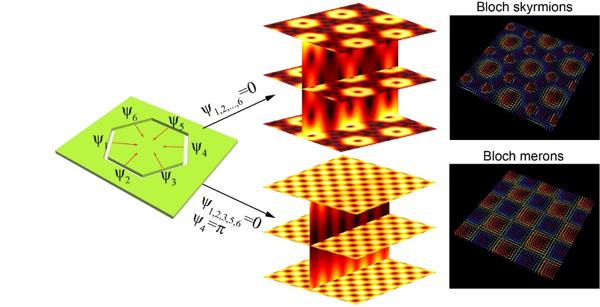Topological photonics mainly focuses on studying the property of waves in periodic structures such as photonic crystals or metamaterials, by investigating their topological band structures in momentum space. In real space, however, there exists also a variety of fascinating topological phenomena, e. g., optical vortices, optical Möbius strips, and optical skyrmions.
The topology of electromagnetic waves is at the focus of growing research efforts recently, in particular with respect to the possibility of emulating and exploiting topological phenomena typically considered in electronic condensed matter.
Team of Assoc. Prof. Zhenwei Xie, Prof. Luping Du and Prof. Xiaocong Yuan from Shenzhen University have demonstrated theoretically a dynamic modulation of optical skyrmion lattice and meron lattice, and showed that the material chirality can twist the spin texture of skyrmions from Neel type to Bloch type. The research results are published in Photonics Research, Volume 10, Issue 4, 2022 (Qiang Zhang, Zhenwei Xie, Peng Shi, Hui Yang, Hairong He, Luping Du, Xiaocong Yuan. Optical topological lattices of Bloch-type skyrmion and meron topologies [J]. Photonics Research, 2022, 10(4): 947-957).
Skyrmions are 2D mappings of the fields that wrap around a 3D parameter space for integer times. This integer is called the skyrmion number. While a meron is characterized by a skyrmion number of either 1/2 or -1/2. Skyrmions can be classified into two types: Neel type and Bloch type. Topologically, Neel type skyrmions are hedgehog-like, while Bloch type skyrmions are spiral-like.
Recently, Neel type optical skyrmion configurations were created in surface plasmon systems, manifested as either electric fields or photon spins. In this paper, the team in Shenzhen University proposed how to control the Bloch type optical skyrmions and merons dynamically.
Chirality is a property of a physical entity that cannot be superimposed with its mirror image, like our hands, and plays an important role in many physical phenomena. The team proposed to combine the twist degree of freedom in both optical skyrmions and chiral materials, in order to investigate theoretically the role of chirality in controlling the topology of electromagnetic waves.
"Compared to achiral optical materials," said by Dr. Zhang, a postdoc of this team, "chiral optical materials have a unique coupling of electric and magnetic dipoles. Therefore, it can benefit the twist of electromagnetic field and by a particular design of the optical system, Bloch type skyrmions and merons can be realized."
They proposed a metal-chiral-metal slab waveguiding structure with a hexagonal slit surface plasmon excitation configuration. They showed that material chirality modulates the twist of skyrmion textures, leading to a transition of twisted Neel type-Bloch type-reverse twisted Neel type from the top boundary to the bottom boundary, and that the rotational symmetry of the surface plasmon excitation condition (phase modulation) governs the transformation between skyrmions and merons.
The results can enrich the portfolio of optical quasiparticles. The chiral route to topological state transitions will deepen the understanding of light-matter interaction and pave the way for chiral sensing, optical tweezers, and topological phase transitions in quantum matter.

Schematic of a dynamic modulation between Bloch type skyrmion lattice and meron lattice in a surface plasmon system including chiral material


